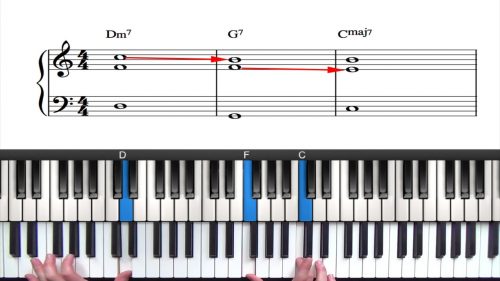Diatonic 7th Chords in F Major
Welcome to lesson 1 in our course on Bluesy Jazz Piano for Beginners. This first lesson is a short harmonic study in the key of F Major in preparation for the upcoming jazz standard tutorials.
Before starting to arrange the tune “Georgia On My Mind” we will discuss the diatonic 7th chords in the key of F Major, how to create 3-note spread voicings, and how to construct common chord progressions such as the major 251 progression and the 36251 progression.
“Georgia On My Mind” in F Major
“Georgia” is written in the key of F Major and so in this first lesson we will quickly explore the diatonic chords in the key of F Major. This will will help us to understand the harmony of the tune and also to memorise the chord changes quickly and effectively.
Diatonic 7th Chords & Exercises
We start by playing the diatonic 7th chords from the F major scale. In jazz piano we use 7th chords as a minimum when arranging jazz standards to create a rich and jazzy sound.
See our Jazz Piano Foundations Course for more information on 7th chords and the other essential components of jazz harmony such as intervals, triads, and the 251 progression.
In the first exercise we play the root in the left hand and the 7th chord in the right hand in root position. Next we play the root in the left hand, and just the 3rd and 7th in right hand which is creates the basis for the 3-note voicings that we will use to arrange the tune.
3-note spread voicings create very little movement compared to the root position voicings and we use this voicing style when arranging jazz standards for solo piano.
The 251 Progression In F Major
Next we play the 251 Progression in F Major which is the most common progression in jazz music. It is possible to play a 251 with the chords in root position. However, when playing jazz standards we use spread voicings to create a more balanced sound.
If you are new to this theory, continue with the lessons in this course but also be sure to watch the lesson on the major 251 progression and also the 251 whole step drill lesson which can be found in the Related Lesson section below.
The 36251 Progression In F Major
Finally we explore the 36251 Progression in F Major and we must first find the diatonic 7th chords from the F major scale. We can play these chords in root position but we are going to play with spread voicings to get the 3-note voicing shapes ‘under our fingers’.
An important point to understand is that the 6 chord is usually played as a dominant chord. This is particularly true when playing bluesy jazz standards such as “Georgia On My Mind” – more on this in the next lessons.
Lesson Downloads
-
F Major – Diatonic Workout File Type: pdf
Practice Tips
-
Harmonise the F Major scale using 3-note spread voicings and play up and down the scale. Say the chord names aloud as you play each chord.
-
Memorise the chord qualities of the major scale diatonic 7th chords. This is the same in every major key and so it's important to memorise this pattern.
-
Construct the 251 and 36251 progressions in the key of F Major and visualise the half step voice leading when using 3-note spread voicings.
-
If some elements of this lesson do not make sense right now, don’t worry about it. As we progress through this course everything will fit together.








Thanks for an excellent lesson Hayden. Your teaching is just top-notch. I am very grateful :)
My pleasure Rishi – I’m glad that you enjoyed the lesson.
I will be adding more lessons to this course so more to come!
Cheers,
Hayden
I appreciate all you are doing for us, Hayden. You somehow make the difficult simple, and the learning fun. That is not easy to do, and we all benefit.
My question: could you explain the harmonic function of the Bbm7 Eb7 (the ii V) in bar 4? I understand that the previous chord, the Bm7b5 is also a Dm6, so that is diatonic, but this ii V is not diatonic AND it doesn’t lead to its I chord. I find this puzzling.
Thanks.
Hi Mary,
Good question!
Harmonically, the Bb-7 and Eb7 can be used to resolve into Fmaj7, this is known as the ‘backdoor 251 progression’, sometimes it can also be referred to as the iv minor.
This is quite advanced if you are just starting out with jazz theory, but you can read more here: en.wikipedia.org/wiki/Backdoor_progression
We find the backdoor 251 progression in many tunes: (Misty, Tenderly, Over The Rainbow, There Will Never Be Another You, just to name a few that we cover here on PianoGroove). Tuomo created a tutorial on this here with some tune and theory examples: pianogroove.com/jazz-piano-lessons/the-4-minor-chord/
I replied to a student on that topic in the comments section of this lesson: pianogroove.com/jazz-piano-lessons/over-the-rainbow-tutorial/ – see the discussion with Lonnie.
I hope that helps Mary, and let me know if you have any further questions.
Cheers,
Hayden
Thank you so much, Hayden. This is great information.
Mary
Hi Hayden, I am just returning to this material after a brief lapse and realize I need to. Review a few things. Thank you., Sue Lewis